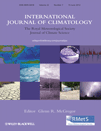
INTERNATIONAL JOURNAL OF CLIMATOLOGY
Scope & Guideline
Fostering innovation in climatology and environmental dialogue.
Introduction
Aims and Scopes
- Climate Variability and Change:
Research on the long-term trends and variability of climate parameters such as temperature, precipitation, and extreme weather events, utilizing observational data and climate models. - Regional Climate Studies:
Focused investigations into specific regions' climate characteristics, including the impacts of local geography and climate systems on weather patterns and climate extremes. - Climate Modeling and Simulations:
Development and evaluation of climate models, including the Coupled Model Intercomparison Project (CMIP) phases, to simulate and project future climate scenarios. - Hydroclimate Interactions:
Studies examining the interactions between climate and hydrological processes, including precipitation variability, droughts, floods, and their impacts on water resources. - Extreme Weather Events:
Analysis of the characteristics, frequency, and impacts of extreme weather events such as heatwaves, heavy rainfall, and tropical cyclones, with a focus on their underlying mechanisms. - Climate Impacts and Adaptation:
Research on the implications of climate change for ecosystems, agriculture, water resources, and human health, along with strategies for adaptation and mitigation.
Trending and Emerging
- Machine Learning in Climate Science:
The application of machine learning techniques for climate modeling, data analysis, and prediction is on the rise, offering new ways to handle large datasets and improve predictive accuracy. - Climate Change Impacts on Ecosystems:
Research examining the effects of climate change on biodiversity, ecosystem services, and the resilience of natural systems is gaining traction, highlighting the importance of ecological perspectives in climate science. - Urban Climate Studies:
Investigations into urban heat islands, climate resilience in cities, and the impacts of urbanization on local climates are increasingly prominent, driven by rapid urbanization and the need for sustainable urban planning. - Compound Extreme Events:
Research focusing on the interactions and cumulative impacts of multiple extreme weather events (e.g., heatwaves combined with droughts or floods) is emerging as a critical area of study. - Climate Justice and Social Impacts:
The integration of social science perspectives into climate research, particularly regarding the equitable distribution of climate impacts and adaptation strategies, is gaining importance. - High-Resolution Climate Projections:
Increasing emphasis on high-resolution climate modeling to capture localized climate phenomena and improve the accuracy of climate projections at regional scales.
Declining or Waning
- Historical Climate Reconstructions:
Research focusing on reconstructing past climates using proxy data sources has seen a decrease, possibly due to the growing reliance on advanced modeling techniques and real-time observational data. - Static Climate Classification Systems:
Traditional climate classification schemes that do not incorporate dynamic changes or regional variability are becoming less favored as researchers seek more nuanced and flexible approaches. - Localized Weather Phenomena Studies:
Studies concentrating solely on localized weather events without broader climatic context are diminishing, as there is a stronger push for research that connects local phenomena to global climate trends.
Similar Journals
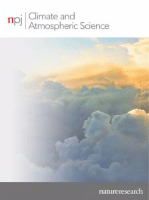
npj Climate and Atmospheric Science
Connecting research to real-world climate solutions.npj Climate and Atmospheric Science, published by NATURE PORTFOLIO, is a premier Open Access journal dedicated to advancing the understanding of climatic and atmospheric phenomena. Since its inception in 2018, this journal has positioned itself as a leader in its field, achieving Q1 ranking in 2023 across key categories such as Atmospheric Science, Environmental Chemistry, and Global and Planetary Change. With a Scopus rank of #23 out of 148 in Earth and Planetary Sciences and a commendable percentile ranking, npj Climate and Atmospheric Science serves as an essential platform for disseminating high-quality research, fostering interdisciplinary collaboration, and addressing critical global challenges. Its open access policy ensures that vital research findings are available to a broad audience, facilitating scholarly engagement and innovation. Researchers, professionals, and students in the fields of environmental science and climate studies will find this journal a valuable resource for cutting-edge studies and transformative insights.
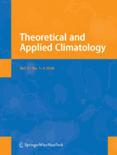
THEORETICAL AND APPLIED CLIMATOLOGY
Exploring Theories and Applications in ClimatologyTHEORETICAL AND APPLIED CLIMATOLOGY is a prestigious international journal published by Springer Wien, dedicated to advancing knowledge in the field of climatology and atmospheric sciences. With an ISSN of 0177-798X and an E-ISSN of 1434-4483, this journal serves as a vital platform for researchers and professionals to disseminate essential findings and theoretical advancements in climate studies. Notably ranking in the Q2 category of Atmospheric Science with a Scopus rank of #44 out of 148, it holds a significant 70th percentile position in the field, underscoring its reputation and impact within the academic community. An established publication since 1986, it attracts contributions that explore both theoretical frameworks and applied methodologies, enhancing climate-related policymaking and real-world applications. As a non-open access journal, it provides depth and rigor in its peer-reviewed articles, making it an essential read for anyone engaged in climatology research, whether you are a seasoned expert or an emerging scholar eager to contribute to this dynamic field.

Atmospheric Science Letters
Unlocking the secrets of the Earth's atmosphere.Atmospheric Science Letters, published by WILEY, is a leading open-access journal in the field of Atmospheric Science. Since its establishment in 2000, it has significantly contributed to advancing knowledge related to the Earth's atmosphere, focusing on both theoretical and practical aspects. With an impressive Q2 ranking in the Atmosphere Science category as of 2023 and a Scopus rank of 62 out of 148, this journal provides a platform for researchers and professionals to share their findings and insights. The journal’s commitment to open access since 2016 ensures that cutting-edge research is accessible to a global audience, fostering collaboration and innovation in the atmospheric sciences. Addressed from its headquarters at 111 River St, Hoboken, NJ, USA, Atmospheric Science Letters is pivotal for students, researchers, and professionals seeking to stay abreast of the latest developments in this dynamic field.

Journal of Southern Hemisphere Earth Systems Science
Empowering Scholarship for a Resilient Planet.The Journal of Southern Hemisphere Earth Systems Science, published by CSIRO PUBLISHING, stands as a pivotal resource for researchers and professionals in the fields of Atmospheric Science, Global and Planetary Change, and Oceanography. Established in 2016 and operating under an Open Access model since 2019, this journal provides a platform for innovative research and critical discourse on earth systems in the Southern Hemisphere. It has achieved impressive rankings with a Q1 classification across key disciplines and is recognized in Scopus with significant percentile rankings, showcasing its influence and relevance within the scientific community. The journal is dedicated to fostering scholarship that addresses the complex interactions of earth systems, offering valuable insights for those engaged in environmental science and sustainability initiatives. Its commitment to facilitating open access resources makes it an invaluable tool for researchers and students alike, striving to enhance our understanding of global environmental changes.
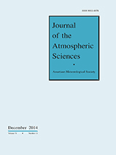
JOURNAL OF THE ATMOSPHERIC SCIENCES
Elevating the Standards of Meteorological ResearchJOURNAL OF THE ATMOSPHERIC SCIENCES, published by the American Meteorological Society, stands as a premier resource for the latest research in atmospheric sciences. With an impressive impact factor and a Q1 ranking in the Atmospheric Science category for 2023, this journal is recognized for its rigorous peer-reviewed articles that contribute to the understanding and advancement of weather, climate, and dynamics of the atmosphere. Established in 1969, the journal has maintained high academic standards and delivers valuable insights spanning over five decades, thus catering to an audience of researchers, professionals, and students alike. Although it does not offer open-access options, it provides critical access through various institutional subscriptions, ensuring that significant research findings are disseminated widely within the scientific community. The journal's address is located at 45 Beacon St, Boston, MA 02108-3693, United States, and it accepts submissions and articles until 2024, continuing its legacy of excellence in atmospheric research.
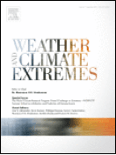
Weather and Climate Extremes
Unlocking Insights into Climate Variability and ResilienceWeather and Climate Extremes is a premier open access journal published by Elsevier, dedicated to advancing the understanding of extreme weather and climate phenomena from 2013 onwards. With an impressive impact factor, this journal ranks in the Q1 quartile across several categories including Atmospheric Science and Geography, Planning and Development, highlighting its significance in the field. The journal serves as a vital platform for researchers, professionals, and students, enabling them to disseminate their findings on climate variability, response strategies, and policy implications. Its accessibility ensures a wide reach, fostering collaboration and innovation while building a comprehensive repository of knowledge to address the challenges posed by climate extremes. The journal’s commitment to quality research is reflected in its Scopus rankings, with top placements across multiple disciplines, signaling its influence in shaping the discourse on climate and ecological management.
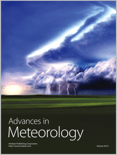
Advances in Meteorology
Empowering Innovation in MeteorologyAdvances in Meteorology is a renowned open-access journal published by Hindawi Ltd, dedicated to the dynamic field of meteorology and related atmospheric sciences. Since its inception in 2009, this journal has served as a vital platform for researchers and professionals, facilitating the dissemination of cutting-edge research that advances our understanding of atmospheric phenomena. With a commendable impact in the realms of Geophysics, Atmospheric Science, and Environmental Pollution, it boasts impressive Scopus rankings—34th percentile in Geophysics, 54th in Atmospheric Science, and 61st in Environmental Pollution—highlighting its significance and relevance in these critical areas. The journal's commitment to open access ensures that vital research reaches a wide audience, fostering collaboration and innovation within the scientific community. Positioned with a mix of rigorous research and interdisciplinary approaches, Advances in Meteorology continues to shape the landscape of atmospheric science research from its base in Egypt, addressing pressing global challenges related to climate and environment.

Atmosphere
Unlocking the Secrets of Climate and Air QualityAtmosphere is a premier open-access journal dedicated to the field of atmospheric sciences, published by MDPI since 2010. With an E-ISSN of 2073-4433, the journal has established itself as a significant platform for the dissemination of research on atmospheric processes, climate change, and environmental dynamics. Based in Switzerland, the journal has garnered impressive recognition within the academic community, currently ranked in the 3rd quartile for Atmospheric Science and the 2nd quartile for Environmental Science (miscellaneous) as of 2023. Notably, it holds a commendable Scopus rank, emphasizing its impact with a 69th percentile standing in its category. Atmosphere aims to foster innovative research and comprehensive reviews that contribute to the understanding of air quality, climate policy, and environmental sustainability. Its open-access model not only supports the global sharing of knowledge but also enhances visibility and engagement among researchers, professionals, and students alike, making it an essential resource for anyone invested in the study of our planet's atmosphere.
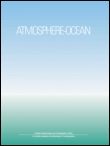
ATMOSPHERE-OCEAN
Uniting Atmospheric Insights and Oceanic DiscoveriesATMOSPHERE-OCEAN is a premier peer-reviewed journal published by Taylor & Francis Ltd, dedicated to advancing the fields of atmospheric science and oceanography. Since its inception in 1963, this journal has served as a crucial platform for researchers, professionals, and students, facilitating the dissemination of significant findings and innovative methodologies in understanding the complex interactions between the atmosphere and the ocean. With its journal ranking in the Q3 category for Atmospheric Science and Q2 for Oceanography as of 2023, along with its Scopus rankings, ATMOSPHERE-OCEAN maintains its relevance by addressing current topics such as climate change, hydrology, and ocean circulation patterns. For those seeking to contribute to or stay informed about the latest research in these critical fields, ATMOSPHERE-OCEAN is an invaluable resource that combines rigorous scholarship with practical implications for environmental management and policy.

Idojaras
Elevating the discourse in weather and climate studies.Idojaras, a prominent journal published by the Hungarian Meteorological Service, has been a vital contributor to the field of Atmospheric Science since its inception in 1980. With a specific focus on the intricacies of weather phenomena, climate variability, and environmental change, this journal serves as a platform for researchers and professionals to disseminate their findings. Although currently categorized in Q4 of Atmospheric Science with a Scopus rank of #122 out of 148, Idojaras is dedicated to improving its impact and visibility through rigorous peer-reviewed research and comprehensive analyses that engage a global audience. This scholarly publication, which operates without open access, is pivotal for advancing knowledge in meteorological studies, thereby appealing not only to seasoned scientists but also to students and scholars eager to explore this dynamic field. Located in Budapest, Hungary, the journal continues to strive for excellence in its coverage through the convergence of past and present meteorological research, making it a significant resource for anyone interested in the atmospheric sciences.